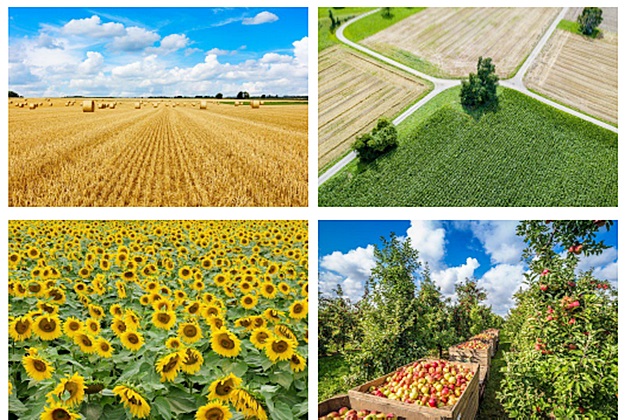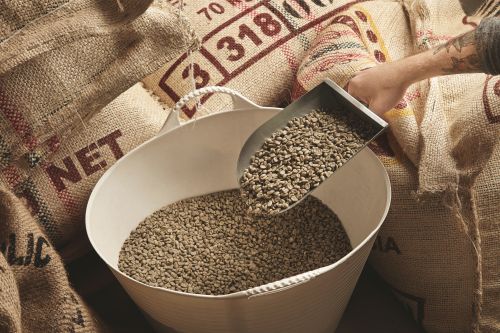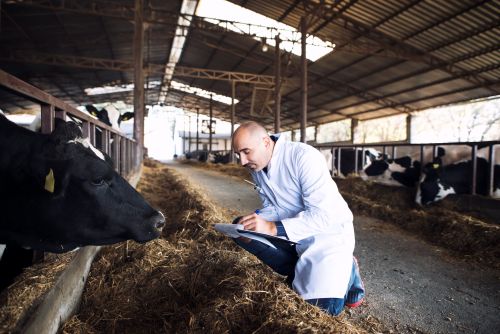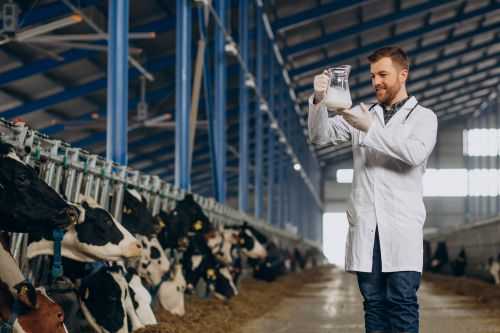
While processing and consumption price indices have resisted this downward movement for some time, they have ceased to rise in recent months, which could bring some relief to domestic food demand in the coming months. The impact of unfavorable weather conditions and uncertainty about developments in Ukraine could, however, pose increasing risks to commodity and agricultural product prices, according to the latest estimate from the European Commission regarding agricultural production in the year 224.
EU market remains attractive
The recovery of EU exports for certain agricultural commodities has been supported by more competitive prices for EU goods. This is likely to continue in 2024, as the EUR-USD exchange rate is expected to remain relatively low. On the other hand, the EU market remains attractive for imports.
The EU macroeconomic situation has been slightly revised downward from the outlook in the summer of 2023, with the EU economy contracting in the first half of 2023 and a stricter monetary policy to combat inflation. Weaker growth is expected to extend into 2024.
Cereal production
EU cereal production in 2023/2024 is estimated at 268.5 million tons (4.3% below the 5-year average), mainly due to unfavorable spring and summer weather conditions, which negatively affected especially corn and barley production (13% and 7% below the 5-year average, respectively).
Cereal use in the EU is stable compared to the last trading year but 1.4% below the 5-year average. Since overall EU livestock production remains relatively stable (but varies between species), an increase in cereal use for animal feed is expected to be quite marginal (+0.3%), while the use of cereals for biofuel production continues to grow (12% over 2022/23).
After a historically high level of cereal imports into the EU in 2022/23, they are likely to be lower in 2023/24, although still above the 5-year average.
Oilseed production in the EU in 2023/24 is expected to be 33 million tons (11% above the 5-year average), mainly due to an excellent rapeseed harvest (13.3% above the 5-year average). With a production of 4.6 million tons, availability of protein crops will be higher (7.7% above the 5-year average).
Sugar production
EU sugar production in 2023/24 is estimated at 15.6 million tons (close to the 5-year average), as sugar beet planting area, sugar beet yield, and sugar content are expected to increase.
EU isoglucose production, which was estimated to decrease by 24% in 2022/23 due to the consequences of the 2022 summer drought, high raw material costs, and inputs in the main EU producing countries, is expected to partially recover in 2023/24.
EU cereal production in 2023/24 is estimated at 268.5 million tons, just 1% above the previous trading year, despite a slight reduction in cultivated area (-1% from 2022/23). It is lower than expected in the early summer due to unfavorable weather conditions in some EU regions during spring and summer, negatively affecting crops.
Prolonged wet conditions during the harvest period have negatively affected the quality of cereals, and a larger proportion of cereals is expected to be suitable only for animal feed consumption.
Cereal yield
Cereal yield growth is expected to be higher than anticipated (2% above 2022/23), but still 1.3% below the 5-year average. In 2023/2024, EU soft wheat production is expected to remain stable (125.3 million tons), while corn production is estimated to recover from the very low level harvested last year (+15% to 59.8 million tons).
An increase in sorghum and rye production (+41.6% and +4.2%, respectively) is forecasted, driven by increased acreage, while the most significant production reductions are expected for oats (-14%) and barley (-6%) as the main producing regions in ES and northern EU were affected by unfavorable weather conditions (drought in ES and drought followed by heavy rains in the north).
Stable domestic production and relatively large starting stocks could lead to lower imports. Improved logistic solutions developed to facilitate Ukrainian cereals reaching its traditional markets in Africa and Asia should result in lower exports to the EU than the previous season.
A decrease in imports is expected for soft wheat (-31%), barley (-26%), and corn (-23%), while imports could increase for durum wheat (+30%) due to lower initial stocks. EU cereal exports are expected to remain stable, slightly above the 5-year average (+3.5%), supporting the EU's net export position.
Cereal use
No substantial change is expected in cereal use in the EU (+1% compared to 2022/23), remaining below the 5-year average (-1.4%). Stable use levels in the EU could be determined by nearly constant use of animal feed (+0.3%), reflecting a relatively stagnant EU livestock production expected in 2023/24.
High-quality cereal feed in the EU offers good opportunities for livestock producers to use EU feed and rely less on imports. Cereal use for industrial purposes is expected to increase slightly from 2022/23 (+3.8%). 12 million tons of cereals (one-third of total industrial uses, +12% from 2022/23) could be used to produce biofuels. This represents a return to pre-war levels as cereal prices have significantly decreased from the peak in 2022, aiding recovery.
Oilseed production
In 2023/2024, EU oilseed production is expected to be 6% above the last trading year and could reach 33 million tons. This is determined especially by higher soybean (+20%) and sunflower (+14%) production, recovering from very low levels recorded last season.
Rapeseed production, which increased in 2022/23, is expected to be relatively stable at 19.6 million tons in 2023/24, despite a small increase in cultivated area (+1% from 2022/23). Regarding sunflower seeds, there are still challenges for some of the main EU producing countries (RO, BG) due to unfavorable weather conditions.
In comparison to historically high levels of EU imports in 2022/2023, attributed to trade flow challenges from Ukraine and difficulties in utilizing Ukrainian crushing capacity, rapeseed and sunflower seed imports are expected to decrease (15% and -29.5%, respectively), while soybeans.
Bean imports are estimated to increase by 6%, reaching 14 million tons, returning to the average levels of the last 5 years. At the same time, EU exports are likely to remain relatively stable.
EU annual production of oilseed meal is expected to increase only marginally in 2023/24, by 1.3%, to around 31 million tons. Overall, the increase in soybean and sunflower meal production (+7% and +6%, respectively) compensates for the decrease in rapeseed meal (-5%).
Oilseed exports
EU exports of oilseed meal are also expected to increase only marginally (+1.5%), to 2.4 million tons, mainly driven by soybean meal exports (+25%), while rapeseed meal exports could decrease (-13%). EU imports of oilseed meal are estimated to decrease by approximately 5%, except for soybean meal, which could remain stable.
EU vegetable oil production is expected to remain unchanged in 2023/24, at around 17 million tons, as well as consumption (at around 21 million tons). Palm oil use is expected to continue its structural decline (-12.5% this year), in line with the last 5 years.
Both EU exports and imports of oils are expected to decrease in 2023/24, returning to more traditional levels. Exports could rise to 2.6 million tons (-12% from 2022/23) due to lower exports of rapeseed oil (-32%) and sunflower oil (-20%).
Sugar trade
Despite delayed plantings due to wet spring, EU white sugar production in 2023/24 is estimated at 15.6 million tons, 7.0% above 2022/23, and close to the 5-year average of 15.7 million tons. This is a combined result of increased sugar beet planting areas, higher sugar beet yields, and potential sugar content increases.
Due to increased production, EU availability is higher. Therefore, EU sugar imports are estimated to decrease to 1.9 million tons in 2023/24 (25% below the estimated post-quota record of 2.5 million tons imported in 2022/23).
However, imports should remain above the 5-year average due to high sugar prices in the EU and increased availability of Ukrainian sugar, while EU exports compared to 2022/23 should increase by 29%, to 0.75 million tons.
EU total sugar consumption in 2023/24 is expected to remain resistant to high prices and relatively stable compared to 2022/23.
It should continue to be supported by strong EU sugar exports in processed products, while industrial sugar use is expected to partially recover. Final sugar stocks, estimated at 1.4 million tons in 2022/23 (down 9.6% year-on-year), are expected to be at a similar level at the end of the 2023/24 season.
Glucose production
EU isoglucose production in 2022/2023 is estimated to decrease to around 440,000 tons (24% below 2021/22 and 29% below the post-quota record of 620,000 tons in 2020/21).
Production was heavily affected by the consequences of the 2022 summer drought, high raw material costs, and inputs in key isoglucose-producing countries, especially in HU. Due to limited domestic availability, isoglucose exports are also estimated to have drastically decreased to 50,000 tons or 32% below the 2021/22 season level of 73,000 tons. Imports are estimated to have increased but remain marginal at 3,600 tons.
Due to lower production in 2022/23, isoglucose use in the EU is expected to decrease by 21% compared to 2021/22.
With lower input costs and better raw material availability in the 2023/24 season, EU isoglucose production is estimated to increase by about 5%.
Wine production
Initial estimates of EU wine production for 2023/24 suggest an annual reduction of about 6% to a volume of about 150 million hectoliters (4.5% below the 5-year average). The decline in Italian and Spanish production (-12% and 14% year-on-year) is expected to be the main explanation for this decrease. In IT, the main reduction is in the regions of central and southern Italy (Abruzzo, Puglia, and Sicily with a 30-40% decrease).
In ES, despite contrasting developments between regions, excessive precipitation (e.g., Galicia, Castilla y Leon), heat and drought conditions (e.g., Castilla la Mancha and eastern regions) could lead to a substantial decline in yields. There are reports in some regions of lower quality due to smaller-sized grapes, uneven ripening, and diseases.
On the other hand, average harvest is expected in FR (around 45 million hectoliters, +1% year-on-year). Considering the decline in IT, FR is expected to become the largest wine producer in the EU in 2023/24.
A recovery in production is expected in DE (+16% year-on-year) due to sufficient water reserves throughout the growth cycle, as well as in PT (+15% year-on-year), which also reports good grape quality.
Apple production
Unfavorable weather conditions contribute to a decrease in EU apple production in 2023/24. Usable production is expected to be around 12 million tons (-2.4% year-on-year).
This is mainly due to limited pollination in spring, a lack of precipitation over several months, increased pest pressure, and high production costs.
Following the record production in 2022/23, PL, the largest apple-producing country in the EU, is likely to reduce its production to less than 4 million tons. In addition, a smaller-than-average harvest is expected in IT and DE, while some increases could be recorded in FR.
Reduced production, still high storage costs, and heatwaves in the southern EU, causing skin injuries that shorten storage periods, are expected to contribute to a decrease in fresh apple stocks.
On the other hand, this, together with currently low stocks of concentrated apple juice, could keep apple availability for processing stable, after two years when this availability increased. However, this could further change with the evolution of international demand.
Due to lower fresh apple availability in 2023/24, purchases of fresh apples for consumption could decrease and could be around 15 kg per capita (-3.6% annually).




